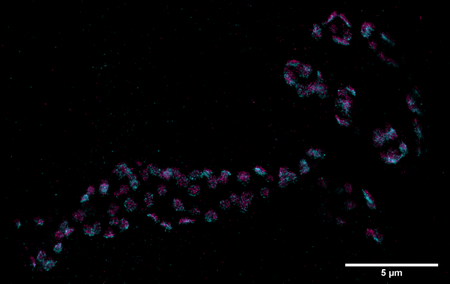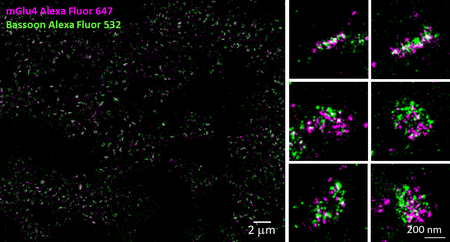Prof. Dr. Markus Sauer | |
Telefon: | +49 931 31-88687 |
Super-Resolution Microscopy | |
| Honors and Awards | |
| 2016 | Gregorio Weber Award for Excellence in Fluorescence Theory & Applications |
| 2013 | Most Cited Article Award of the European Photochemistry and Photobiology Society |
| 1998 | BioFuture Award of the BMBF |
| 1997 | Victor Meyer Award of the University of Heidelberg |
The Receptome harbors an uncharted number of therapeutic applications in health and disease. It comprises the entirety of receptor molecules in an organism and accounts for more than 5% of all proteins. The drug-receptor concept, which exploits the highly specific interaction between diffusible ligands and receptors, has led to the discovery and development of a large number of drugs that target specific receptors. However, despite their central therapeutic relevance, knowledge on specific receptor parameters, particularly for low abundant receptors remains elusive; this includes numbers, different functional states in response to different external stimuli, their distribution and interactions, as well as their operating modes.
In close collaboration with other departments and the university of Jena we aim to investigate receptors at all levels, from molecular mechanisms and functions, to cellular interactions and communication in both healthy and diseased model organisms. Together with the university hospital, we will translate our findings to clinical applications, therein improving current molecular diagnostics and personalized therapies.
The development of super-resolution microscopy has opened a window for the study of cellular processes at a nanomenter scale; it is now possible to investigate quantitatively how receptors are organized and how they interact at the molecular level. From such investigations, we are able to improve our knowledge of the relations between receptor localization, receptor abundance, and receptor functionality, which is key to understanding how alterations of malfunction of any of these parameters can lead to diverse diseases.
Glutamate receptors (GluR) consist of four subunits, IIC, IID, IIE and IIA or IIB. GluR is located on the postsynaptic membrane at the neuromuscular junction (NMJ) of Drosophila larvae. The activity-dependent reorganization of the ionotropic GluR contributes to synaptic plasticity which enables regulation of complex brain functions. Electric stimulation can trigger such receptor dynamics allowing us to study the organization of GluR under different conditions. Together with the group of Robert Kittel (neurophysiology) we aim to obtain quantitative information on the distribution and the movement of GluR subunits. With SIM (structured illumination microscopy) and dSTORM we investigate the arrangement of both receptor types (IIA and IIB) in wild-type and receptor mutants with and without prior stimulation.
NMDA receptor (NMDAR) encephalitis is a synaptic autoimmune disease, in which the body produces antibodies against NMDAR in the brain, which leads to malfunction in synaptic signalling. This can ultimately result in personality disorders, muscle dysfunction, epileptic seizures or other neuronal disorders. In collaboration with the university of Jena we aim to characterize the autoantibodies from patients which recognize the NR1 subunit of NMDAR. We use them to visualize NMDAR in mouse neurons and brainslices with dSTORM to investigate the differences in affinity and postsynaptic distribution. In addition, we mean to study the impact of the autoantibodies on the morphology and function of NMDAR.
G-protein coupled receptors (GPCRs) play a fundamental role in the modulation of synaptic transmission. This function is partially mediated via an inhibition of pre-synaptic calcium influx which ultimately suppresses neurotransmitter release. Until now, only limited information is available regarding the localization of GPCRs at active zones (AZ). In cooperation with the group of Davide Calebiro (pharmacology) we aim to directly analyze the nanoscopic organization of a prototypical presynaptic GPCR at a central excitatory synapse in the cerebellum. Using dual-color dSTORM, we therefor investigate the metabotropic glutamate receptor 4 (mGlu4R) at the synapse between parallel fibers and Purkinje cells in mouse brain slices. Furthermore, we test for a relationship between mGlu4R and other structural and functional components of the AZ.












